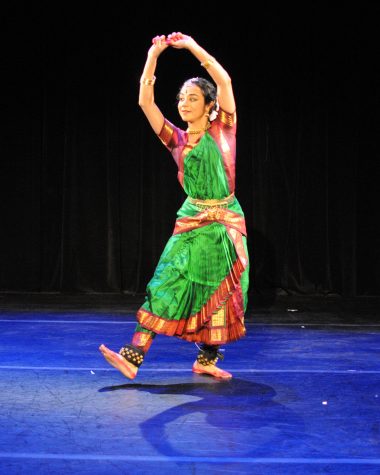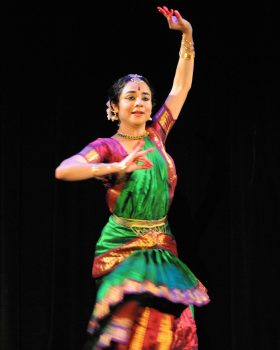A March 13 dance/lecture in the Black Box Theatre was part of the "Religious Studies at the Crossroads" series at Elon.

*****
By Natalie Allison ’13
From the Hindu Bharatanatyam dance embodying Murugan to the Christian expression of the Lord’s Prayer through liturgical dance, members of the Elon University community saw a glimpse of one common thread between two of the world’s major religions Tuesday evening: dance as an act of worship.
“Religion and dance tend to be seen as separate disciplines, but they come together in very interesting ways,” said Katherine Zubko, associate professor of religious studies at UNC Asheville and a panelist at the March 13 event titled “Dancing Across Religions: Embodied Yearnings for the Divine,” part of the “Religious Studies at the Crossroads” lecture series sponsored by the Department of Religious Studies.
Zubko, along with Jane Wellford, a professor of performing arts at Elon University, introduced the dances performed and spoke about their study of Hindu and Christian dance, respectively, in the Black Box Theatre program.
Bharatanatyam dancer Malini Srinivasan performed two numbers, dressed in Indian costume, jewelry and ankle bells to emphasize the rhythm of the music.
“Most of the dance forms come out of the Hindu temple tradition,” Zubko said. “Women were dedicated to the temple and would dance as an offering to the deities, much like you’d invite someone into your home to offer hospitality.”

In Srinivasan’s first dance, she embodied the lover-beloved relationship between human and Murugan, by moving back and forth between describing the deity’s attributes and expressing the devotee’s desire to be with him.
Students in Wellford’s class performed two liturgical dances, the first centered on the theme of the Lord’s Prayer and the second an abstract, modern rendition of Matthew 25:35-40, both choreographed by Wellford.
The abstract number, Wellford said, provided a chilling perspective to how some Christians today might act out the passage of scripture. While the first verse reads Jesus saying “I was hungry and you gave me something to eat,” the dancers walked in a circle, one coming to the center to say, “I was hungry and you formed a humanitarian group to discuss my hunger.” Each dancer took a turn to recite to the audience a statement of the Church’s embodiment of the verses.
Wellford said that though this type of performance isn’t a literal expression of the sacred text, the possibilities in liturgical dance are many. “Arts have the ability to deepen the worship experience, as they can be literal or abstract,” she said.
“Religious Studies at the Crossroads” aims to foster conversations about the academic study of religion across Elon’s campus. It is sponsored by the Department of Religious Studies and the Department of Performing Arts with support from the Truitt Center for Religious and Spiritual Life and PERCS (the Program for Ethnographic Research and Community Studies).


